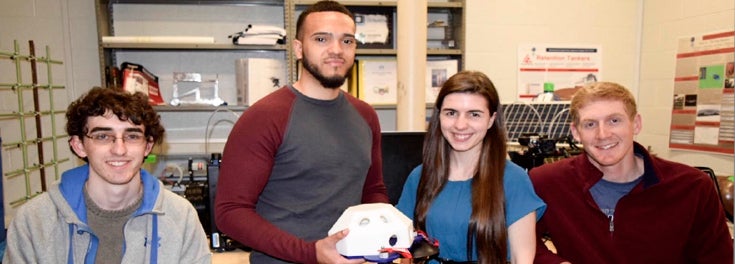
Our engineering students are really flying—and Delta Airlines is taking notice. The airline wants to field test a prototype of a student-designed device that can prevent wingtips on planes from colliding while the aircraft are being towed on the ground.
The Wingman 360 is such a hit that it won first place this year in the University Design Competition for Addressing Airport Needs, a prestigious national contest sponsored by the Federal Aviation Administration. The device is a refined version created by engineering students two years ago, which also won the FAA award.
“This is an incredible opportunity for our students,” said Mechanical Engineering Professor Bahram Nassersharif, who oversees the projects. “The students are not only learning about aviation and airport operations, but also about creating a new device that has the potential to significantly mitigate on-ground aircraft collisions and wing damage during maintenance operations.”
This year’s winning team was made up of seniors Laura Corvese, Mitchell Contente, Cody McMillan, and Gilbert Resto. The device uses ultrasonic sensors attached to a plane’s wingtips to detect when the aircraft gets perilously close to another plane on the ground or to the wall of a hangar.
It’s amazing to think that something I worked on with my team of friends might actually be used on a national level.
“We took a lot of the students’ creative ideas from two years ago and used them in a different way,” Mitchell said. “One of the major changes is that the new device is better for bigger planes.”
Delta heard about the earlier version of the device and reached out to URI, agreeing to sponsor this year’s capstone design program in mechanical engineering. Gilbert did much of the electrical work and coding for the new device, and he said it was exciting as a college student to work with Delta. “It’s a great opportunity to have a hands-on experience and apply everything I’ve learned in my undergraduate career.”
“Our Wingman has the potential to be something very big,” Laura added. “It’s amazing to think that something I worked on with my team of friends might actually be used on a national level.”
URI’s engineering students are keen on aviation safety design. Last year, students won the FAA competition for a drone detection and tracking system—called Eye in the Sky—to address the problem of drones colliding with aircraft after entering the no-fly zones around airports. Using radio frequency identification tags, GPS, and wireless communication, URI students created a solar-powered system that not only alerts airport officials about approaching drones so pilots can be informed, but it also warns drone operators when their vehicles enter the no-fly zone.
“Experiences like these capstone projects are revolutionizing engineering education here at URI,” said Professor Nassersharif. “It’s incredible for our students to be on the leading edge of aviation design.”
